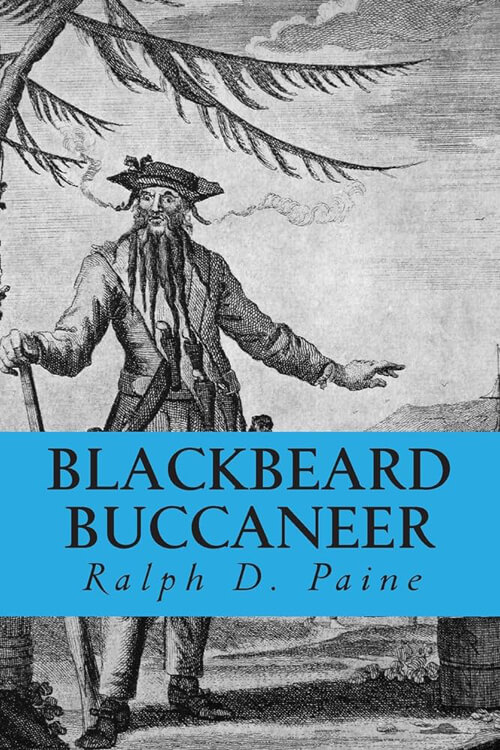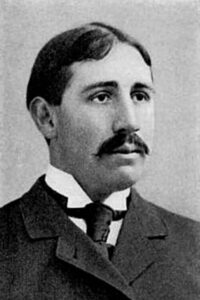
Blackbeard: Buccaneer
He passed by scattered houses and stores which were mere log huts loopholed for defense, with shutters and doors of hewn plank heavy enough to stop a musket ball. The unpaved lanes wandered between mud holes in which pigs wallowed enjoyably. Negro slaves, half-naked and bearing heavy burdens, jabbered the dialects of the African jungle from which they had been kidnapped a few months before. Yemassee Indians clad in tanned deer skins bartered with the merchants and hid their hatred of the English. Jovial, hard-riding gentlemen galloped in from the indigo plantations and dismounted at the tavern to drink and gamble and fight duels at the smallest excuse.
Young Jack Cockrell paid scant heed to these accustomed sights but walked as far as the wharf built of palmetto piling. The wide harbor and the sea that flashed beyond the outer bar were ruffled by a piping breeze out of the northeast. The only vessel at anchor was a heavily sparred brig whose bulwarks were high enough to hide the rows of cannons behind the closed ports.
The lad gazed at the shapely brig with a lively curiosity, as if there was something really interesting. Presently a boat splashed into the water and was tied alongside the vessel while a dozen of the crew tumbled in to sprawl upon the thwarts and shove the oars into the thole-pins. An erect, graceful man in a red coat and a great beaver hat roared a command from the stern sheets, and the pinnace pulled in the direction of the wharf.
“Pirates, to be sure!” said Jack Cockrell to himself, without a sign of alarm. “‘Tis Captain Stede Bonnet and his Royal James. I know the ship. I saw her when she came in leaking last October and was careened on the beach at Sullivan’s Island. A rich voyage this time, for the brig rides deep.”
The coast of South Carolina swarmed with pirates two hundred years ago, and they cared not a rap for the law. Indeed, some of these rascals lived on friendly terms with the people of the small settlements and swaggered ashore to squander the broad gold pieces and merchandise stolen from honest trading vessels. You must not blame the South Carolina colonists too harshly because they sometimes welcomed the visiting pirates instead of clapping them in jail. Charles Town was a village at the edge of a wilderness filled with hostile Indians. By sea, it stood in fear of attack by the Spaniards of Florida and Havana. There were almost no crops for food and among the population were many runaways from England, loafers, and vagabonds who hated the sight of work.
Read or download Book
Ralph Delahaye Paine
Ralph Delahaye Paine (August 28, 1871 – April 29, 1925) was an American journalist and author popular in the early 20th century. Later, he held both elected and appointed government offices.
Life and career
Born in Lemont, Illinois, Paine was the son of Reverend Samuel Delahaye Paine. Rev. Paine was born in London and served in the British Army during the Crimean War before emigrating to America in 1856. Rev. Paine served as a lieutenant in the 2nd Maine Battery during the American Civil War and later was chaplain-in-chief of the Grand Army of the Republic.
While his father was pastor of the Ocean Street Presbyterian Church in Jacksonville, Florida, 115 Paine worked as a reporter for twelve dollars a week. He also frequented a soda fountain in a cigar shop owned by Cuban revolutionary José Alejandro Huau.
Paine attended Hillhouse High School in New Haven, Connecticut, and then Yale University. At Yale, he was on the football and rowing teams and was a member of Skull and Bones. At Yale, he covered athletic news for a news syndicate. This, plus the money he saved reporting in Jacksonville, paid for his education. He graduated in 1894.
After graduating, Paine worked for the Philadelphia Press until 1901. Paine’s connection to Huau came to the attention of newspaperman William Randolph Hearst when American newspapers were publishing frenzied coverage of the Cuban War of Independence. Hearst’s New York Journal had held a contest to determine the “world’s greatest living soldier”, and Cuban revolutionary military commander Máximo Gómez was the winner. The prize was a gold-plated and diamond-encrusted sword inscribed “Viva Cuba Libre” and “To Máximo Gómez, Commander-in-Chief of the Army of the Republic of Cuba”. Hearst needed someone to deliver the sword to Gomez and offered Paine the task. Paine replied, “I am the damn fool you have been looking for.”
Huau got Paine and another reporter, Ernest McCready, on a boat smuggling munitions and soldiers to Cuba, the Three Friends under Captain “Dynamite” Johnny O’Brien. The Three Friends got into a skirmish with a Spanish gunboat and, in the only naval battle of the war, inexplicably triumphed. However, since the US was not participating in the war, O’Brien, fearing legal entanglements and seizure of his vessel, fled and left passengers and cargo on No Name Key. After filing his story in Key West, Paine managed to get on board the Dauntless, which came to retrieve the cargo under the supervision of General Emilio Núñez. He let Paine and McCready on board, but Núñez, annoyed by a delay they had caused, refused to let them off at Corrientes Bay and returned them to Jacksonville. Upon his return, he discovered that he was among those indicted for piracy (a capital crime) in the Three Friends incident. With the assistance of his father, Paine went into hiding for a month. However, one of the co-owners of the boat was a powerful sheriff and future Governor of Florida Napoleon Broward. Thanks to his influence, no witnesses could identify any participants in the affair and the case was dropped. Paine gave the sword to José Huau, who had it delivered to Gómez’s wife in Santo Domingo and returned to his job at the Philadelphia Press.
The Spanish–American War soon broke out, and Paine was aboard the USS New York, the flagship of Admiral William T. Sampson, when it bombed Matanzas. Paine was also among a group of reporters on board the Gussie, an officially sponsored supply vessel whose captain’s extremely poor choice of landing spots resulted in two failed attempts to deliver cargo to Cuban rebels. They came under fire in what was exaggeratedly called the “Battle of Cabañas” by one newspaper and inspiration for a “comic opera” by another.






